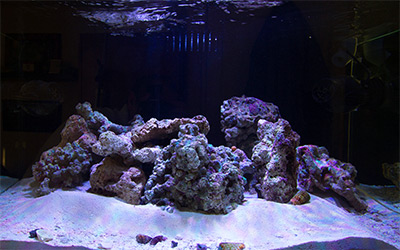Question
I’ll be receiving a shipment of live rocks in a few days, and I could use some advice on how to clean them up before putting them in my tank. Do I just need to give them a good going over with a scrub brush?” – Submitted by Chuck S.
Answer
I wouldn’t use the term “good going over” with respect to cleaning your new live rocks. Remember, you paid good money for the organisms encrusting those rocks, so you don’t want to scrub the entire surface of each rock indiscriminately.
Rather, what you want to do is very selectively scrub/scrape/pluck away any obviously dead/decomposing organisms, slimy films, unwanted algae, and clinging sediments or debris. Encrusting sponges that have been exposed to air will also need to be removed, as they’re likely to die and decompose. Otherwise, if a rock looks pretty “clean” and healthy right out of the box, all it needs is a good rinse.
Tools for the job include:
- A stiff-bristled scrub brush or two (I prefer using brushes with smaller heads, so it’s easy to limit the amount of rock surface affected)
- A clean toothbrush for reaching tight nooks and crannies
- Variously sized aquarium brushes for cleaning holes in the rock if necessary
- Tweezers for plucking stubborn algae that doesn’t yield to brushing
- Two five-gallon buckets
- A heavy-duty plastic storage bin (e.g. 20-gallon)
- Heavy-duty protective gloves and eye protection
I generally clean each rock in a five-gallon bucket filled two-thirds to three-quarters of the way with salt water, give it a good swish in a second bucket of salt water to rinse once I’m satisfied all the undesirable stuff is gone, and then place it immediately in a heavy-duty plastic bin (also containing salt water, of course) for curing.
It’s a good idea to have several extra gallons of clean salt water handy during this process so you can drain off and refill the dirty buckets as well as top off the curing bin if needed to keep the rocks fully submerged.
If you wish and weather allows, you can do the cleaning and rinsing outside with the rocks spread out on a plastic tarp (out of direct sunlight), taking care to keep them moist by regular spritzing with a spray bottle filled with salt water. This step can make it easier to spot certain nasty hitchhikers that drop out of the rocks onto the tarp, such as crabs or mantis shrimps, but it’s not foolproof in this regard. (The nasties don’t always drop out!)
Also note that I mentioned the cleaned rocks are placed into a bin for curing. Even so-called “pre-cured” live rock will undergo some additional die-off of encrusting organisms, which can cause a deadly ammonia spike in an established system. So, unless you’re using the rocks to cycle a new system—which is a perfectly viable option, by the way—you’ll want this die-off to occur under controlled conditions in a separate container with heating and circulation provided.



